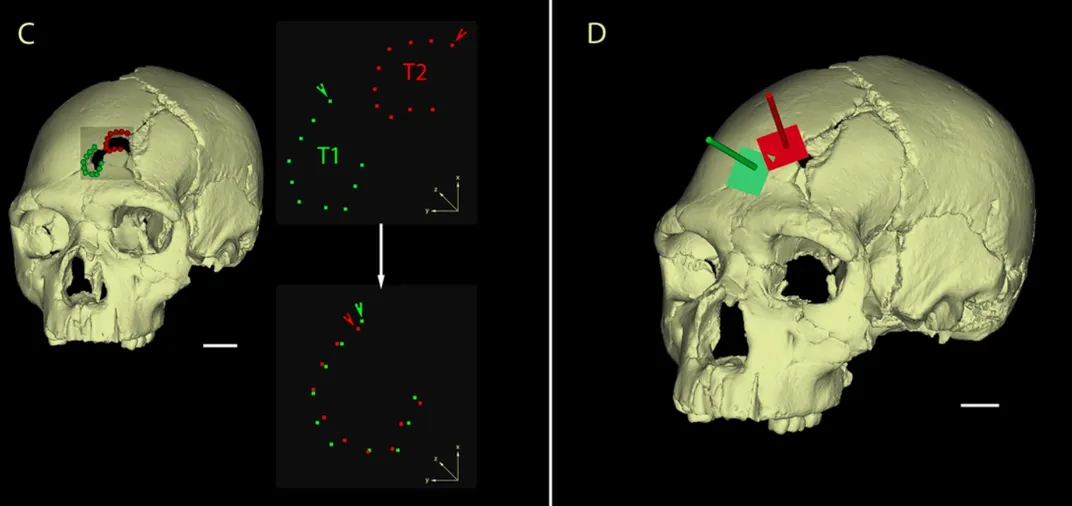Investigating the Case of the Earliest Known Murder Victim
A 430,000-year-old skull discovered in a Spanish cave bears evidence of deliberate, lethal blunt force trauma
:focal(388x483:389x484)/https://tf-cmsv2-smithsonianmag-media.s3.amazonaws.com/filer/84/9d/849dee07-75bc-4351-b1b2-b27dea33388b/92389-sized.jpg)
Violence is often said to be a fundamental part of human nature. Now there’s evidence to support that claim. In a cave in northern Spain, archeological detectives discovered the remains of a 430,000-year-old skull bearing what appears to be lethal, deliberately inflicted blunt force trauma. If the scientists’ interpretation of the wound is accurate, the skull represents the earliest known murder.
To piece this dark story together, an international team of researchers had to assemble the evidence—literally. The ancient hominin skull, called Cranium 17, was discovered broken into 52 pieces, buried under layers of clay in a deep pit within a cavern in the Atapuerca Mountains. The specific site in question, Sima de los Huesos (“Pit of Bones”), was discovered in 1984 and contains the remains of at least 28 early Neanderthal individuals from the Middle Pleistocene, a period ranging from about 781,000 to 126,000 years ago.
The only way to access the site is through a vertical chimney that extends more than 40 feet straight down. Scientists are not certain how the bodies came to be there, but many suspect that they were purposefully deposited. Although little is known about Cranium 17, including the gender of the person it once belonged to, this skull stood out from all the other remains found in the pit. Scientists determined that the person died as a young adult, and the skull features two prominent holes in what once was the forehead, just above the left eye socket.
On first sight, the holes appeared to be the result of blunt force trauma, but the researchers could not be sure just by looking. To vet their hunch, the research team put Cranium 17 through a rigorous round of modern forensic analysis, which they detail in PLOS ONE. They produced a CT scan of the skull and created a 3D model. This allowed them to measure the fracture angle and to recreate the impact trajectories needed to produce such holes, as well as examine crack patterns that indicate whether a wound was inflicted before or after death. Additionally, they studied the bone to see if it showed any signs of healing—an indication that the wound was not fatal.
Cranium 17 showed no evidence of healing, but neither did it appear to have been damaged postmortem. In other words, the victim most likely died from their wounds. In addition, the blows were probably not an accident, the authors say—accidents tend to happen on the side of the head, whereas intentional violence tends to be focused on the face.

The lesions’ position on the left side of the face points to blows coming from a right-handed individual, and past studies indicate that most of the hominins found at Sima de los Huesos were indeed right-handed. The same instrument appears to have made each of the fractures but from different angles, suggesting two independent strikes. Multiple blows usually point to “a clear intention to kill,” the researchers point out. All in all, they conclude, the evidence indicates that the skull’s owner was murdered.
While ancient skeletons examined in past studies have turned up evidence of cannibalism and injury, none of those deaths have definitively been linked to murder. As such, Cranium 17 represents the earliest case of murder in the hominin fossil record, the authors write, “demonstrating that this is an ancient human behavior.”
It's unclear whether the murderer secreted away the body and dumped it into the pit, or if the body was deposited there in a public ceremony. If the other individuals found in the pit were not hidden murder victims or casualties of accidental falls, it seems likely that they were all deposited in the pit purposefully by a group of their peers. In that case, Sima de los Huesos also contains evidence of another first, the authors write: “the earliest funerary behavior in the human fossil record.”
/https://tf-cmsv2-smithsonianmag-media.s3.amazonaws.com/accounts/headshot/Rachel-Nuwer-240.jpg)
/https://tf-cmsv2-smithsonianmag-media.s3.amazonaws.com/accounts/headshot/Rachel-Nuwer-240.jpg)